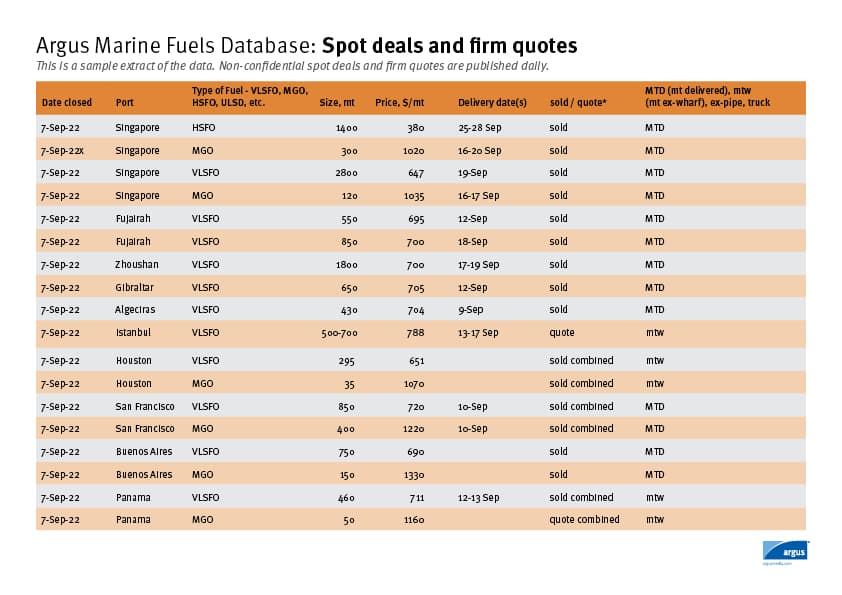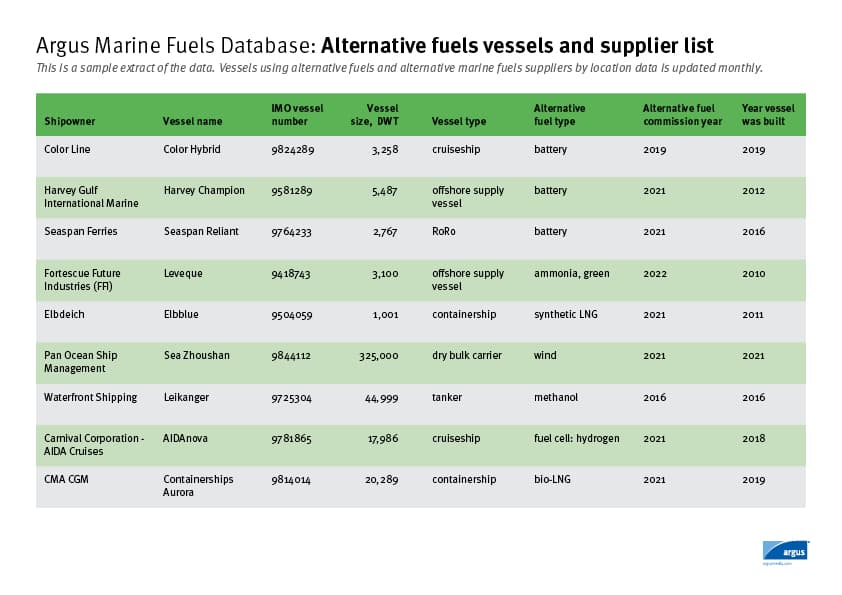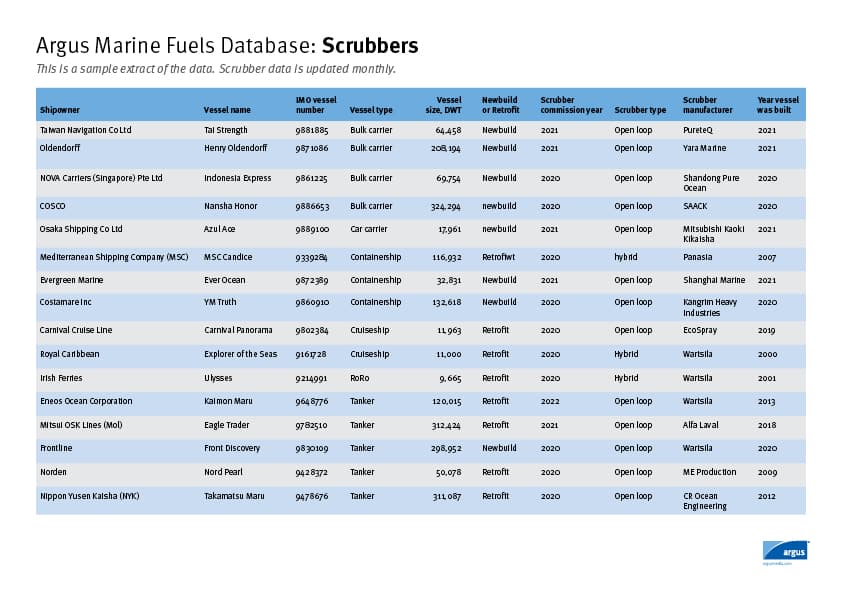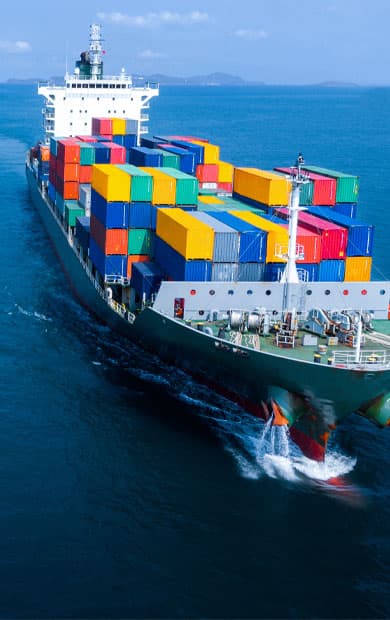Overview
The marine fuel sector is decarbonising. International Maritime Organization (IMO) requirements and EU legislation is driving this change alongside consumer demand for low carbon solutions.
These drivers have prompted shipowners to invest in alternative marine fuels including; marine biodiesel, bio-methanol, grey methanol, LNG, ammonia and hydrogen.
Argus provides pricing, insights, and intelligence for the fast-growing alternative marine fuels market with independent news, analysis, and market commentary on emerging changes and trends so you can stay ahead.

Argus Market Highlights: Marine Fuels
Get the latest industry news, insight and analysis sent directly to your inbox.
Sign upSpotlight content
Browse the latest thought leadership produced by our global team of experts.
Participants diverge on IMO adoption delay
Participants diverge on IMO adoption delay
Sao Paulo, 17 October (Argus) — Market participants had mixed views on the delay in voting on the adoption of the International Maritime Organization's (IMO) net-zero framework, comprising a global emissions pricing mechanism for international shipping. Delegates at the IMO's Marine Environment Protection Committee extraordinary meeting postponed the vote on adopting the net-zero framework for a year on Friday during an extraordinary meeting in London. Some traders and shipowners said that the proposed greenhouse gas (GHG) pricing mechanism is too "optimistic" and that alternative bunker fuel supplies are still scarce. Another participant said the delay was expected, considering opposition from the US and others. A European market participant also called attention to the existence of regional regulations, such as the FuelEU Maritime and the EU emission trading system. The EU previously said there are review clauses built into existing maritime regulations, which would mean that the EU can review or amend if IMO matches its ambitions . The International Chamber of Shipping's secretary general Thomas Kazakos said that he is "disappointed" that IMO members were not able to agree on a way forward. "Industry needs clarity to be able to make the investments needed to decarbonise the maritime sector, in line with the goals set out in the IMO GHG strategy", Kazakos added. Danish industry, business and financial affairs minister Morten Bodskov described the outcome as a "sad day for the green transition", adding that a global agreement is needed "as soon as possible". It is "crucial" for European shipping companies, who need "clear and predictable conditions for the green transition", he said. Another trader said that the delay was discouraging and claimed that as long as US president Donald Trump is in office, the GHG global pricing mechanism proposal will not be approved. Also, shipowners are making investments in alternative-fuelled vessels, another participant said. The European Community Shipowners' Associations and the Global Maritime Forum also lamented the outcome. By Natália Coelho Send comments and request more information at feedback@argusmedia.com Copyright © 2025. Argus Media group . All rights reserved.
NZF remains very much alive: IMO secretary general
NZF remains very much alive: IMO secretary general
London, 17 October (Argus) — The International Maritime Organization (IMO) secretary general Arsenio Dominguez said the net-zero framework (NZF) "remains very much alive" even though member states today voted to adjourn an adoption vote for a year. Speaking at the conclusion of this week's extraordinary Marine Environment Protection Committee (MEPC) session, Dominguez said the decision was only to adjourn and there remains a work plan to be discussed and agreed. It is not a "blow to the organisation", he said, noting the Intersessional Working Group on the Reduction on Greenhouse Gas Emissions from Ships is still scheduled to meet next week to discuss and continue work on guidelines for implementing the NZF. The "outcome today was because the member states required more clarification on the amendments," Dominguez said. But he confirmed that IMO procedures allow for further adjournment to an adoption vote. Dominguez said he knew the stakes were high, pointing to an "intense" process that began with the 2023 adoption of a revised greenhouse gas (GHG) emissions strategy. Dominguez also acknowledged geopolitics are having an effect on NZF discussions. He did not provide a firm response to a question on whether the adoption delay would result in a later start date for the GHG pricing mechanism, but he acknowledged that IMO rules require 16 months from adoption to enforcement. Dominguez said concerns were raised about how amendments will be implemented and how the proposed net zero fund will be administered. Dominguez also said the way of implementing the NZF is yet to be defined, since proposals can be adopted via tacit or explicit acceptance. He said while both procedures exist in the convention, tacit acceptance has served the organisation very well in all its work so far and that he looks forward to maintaining that approach for the NZF. Asked about how companies can make investment decisions, ranging from new vessel orders to fuel procurement, in light of the NZF uncertainty, the secretary general said: "The more proactive we are in this industry, the more it brings additional clarity to the framework." By Hussein Al-Khalisy and Gabriel Tassi Lara Send comments and request more information at feedback@argusmedia.com Copyright © 2025. Argus Media group . All rights reserved.
IMO meeting fails to adopt GHG pricing
IMO meeting fails to adopt GHG pricing
London, 17 October (Argus) — Member states of the International Maritime Organization (IMO) today failed to adopt a global greenhouse gas (GHG) emissions pricing mechanism for international shipping. Delegates voted to adjourn this week's extraordinary Marine Environment Protection Committee (MEPC) session by one year, delaying an adoption vote for the net-zero framework (NZF) that includes the GHG mechanism. The motion to adjourn was proposed by the Saudi Arabian delegation after multiple breaks and delays during the week . The motion was supported by 57 countries, including the US and some member states that voted in favour of the NZF structure in April . Votes against came from 49 member states including Brazil and Denmark, while 21 abstained including Greece, Cyprus, and Japan. Some delegates told Argus the vote in favour of adjournment was reflective of a vote against adoption, pointing to the unlikelihood of achieving further consensus within the year. Others described the outcome as a state of "limbo", which leaves room for further possible delays, and that the adjournment was more attributed to "outside pressures" than concerns about the NZF text. Some delegates maintained a more optimistic view, saying momentum for a global GHG pricing mechanism remains and an agreement will be reached — albeit with potential modifications. The outcome followed a week of tense negotiations including multiple procedural objections that was described by the IMO secretary general Arsenio Dominguez as "not the normal". He urged member states to not "repeat the way we have approached this meeting in other discussions". The Intersessional Working Group on the Reduction on Greenhouse Gas Emissions from Ships is still scheduled to meet next week to discuss and continue work on the guidelines for implementing the NZF. By Hussein Al-Khalisy and Gabriel Tassi Lara Send comments and request more information at feedback@argusmedia.com Copyright © 2025. Argus Media group . All rights reserved.
Delays cast pall over IMO vote
Delays cast pall over IMO vote
London, 16 October (Argus) — Multiple delays during Thursday's Marine Environment Protection Committee (MEPC) meeting has cast a shadow on Friday's vote on the net zero framework (NZF) for marine fuel global greenhouse gas (GHG) emissions pricing. The drafting group for the International Maritime Organisation's (IMO) pricing mechanism released the final text by midday Thursday, but a vote was pushed to Friday as multiple breaks were called for ongoing "consultations" between member states. A delegate told Argus that the discussions have turned "high level" and expressed uncertainty about the outcome. Some delegate have also expressed uncertainty about whether IMO has a sufficient mandate to implement the GHG pricing mechanism as is, even if a vote goes through narrowly. The emissions pricing mechanism has faced particular opposition from the US this year, which has flipped its prior support for such measures under President Donald Trump. On Thursday afternoon Trump railed against the proposal on social media, saying "The United States will NOT stand for this Global Green New Scam Tax on Shipping, and will not adhere to it in any way, shape, or form." He called on other countries to join the US in voting against the proposal Friday. Member states will also have to vote on a number of amendments, including one the US delegation submitted asking for an "explicit acceptance" or "opt-in" procedure for parties to accept the proposed NZF. Under this proposal, the regulation would come into effect only after two-thirds of the parties — or parties whose combined merchant fleets constitute not less than 50pc of gross tonnage of the world's merchant fleet — voluntarily communicate to the IMO the acceptance of the framework. This proposal from the US could delay the maritime sector's adoption of the NZF by years, even if the mechanism is approved, delegates told Argus. But the US delegation argued that the regulation would still come into force by the current planned date if the explicit acceptance threshold is achieved by 1 September 2026. The explicit acceptance mechanism was used in the past for International Convention for the Prevention of Pollution from Ships (MARPOL)'s Annex VI to come into force. The Annex was approved in a convention in 1997, but came into force only in 2005, when two thirds of the countries voluntarily opted in. The UAE also issued a proposal, discussed in the plenary, relating to concerns of having existing regional mechanisms such as the EU emissions trading system (ETS) remain on top of the IMO NZF, creating a "dual regulatory system" which would result in "uncertainty and duplication". The EU previously said there are review clauses built into existing maritime regulations, which would mean that the EU can review or amend if IMO matches its ambitions . The UAE's proposal attracted a significant number of supporters, before the session was stopped for breaks after delegates diverged on the sequencing of discussion. The vote on adoption is now expected to be held on Friday, and will require two-thirds of the majority of International Convention for the Prevention of Pollution from Ships (MARPOL) Annex VI signatories to vote in favor for adoption. There are 95 out of 108 MARPOL Annex VI signatories currently present. By Hussein Al-Khalisy and Gabriel Tassi Lara Send comments and request more information at feedback@argusmedia.com Copyright © 2025. Argus Media group . All rights reserved.
Webinars
Biofuels Waste-Based Feedstocks Market Overview and Outlook
As of mid-2025, the waste-based feedstocks market for biofuels in Europe and Asia is experiencing a mix of stability and pressure, shaped by regional dynamics, policy shifts, and changes in global trade flows.
On demand Webinar - 12/06/25SAF Horizons - Global Market Dynamics, Policy Shifts, and Forecasts
We will hear from our freight experts as SAF policy and demand create global trading opportunities in this market.
On demand Webinar - 21/05/25Zooming into the US feedstock market and futures contracts
North America market updates, including recent regulatory changes like 45Z that are driving these markets
On demand Webinar - 06/05/25A webinar series exploring the shifting dynamics in the oil market
Explore how tariffs could influence global oil demand and reshape production dynamics.
Related documents
Alternative marine fuels key prices
Argus Marine Fuels features a comprehensive range of alternative marine fuels prices (in $/t VLSFO, $/t HSFO, and $/t MGO equivalents and $/mn Btu).
Latest events
Global alternative fuels vessel databases
Argus Marine Fuels includes access to proprietary data in three downloadable databases, providing essential insights into the changing marine fuels market:

Spot deals and firm quotes
This list of spot deals gives buyers and sellers understanding where they stand price-wise compared with their competitors. Argus’ daily deals/quotes detail the port, type of fuel, size of the deal, price, delivery method and delivery dates. It does not include counterparties’ names.
View sample data
Alternative fuels vessels and supplier list
Argus lists vessels that are burning alternative marine fuels, including methanol, biofuels, ammonia, hydrogen, LNG, LPG, as well as those running on batteries. The database is updated every month.
View sample data
Scrubbers
The database is updated every month. It contains over 4,300 records and counting.
View sample data

